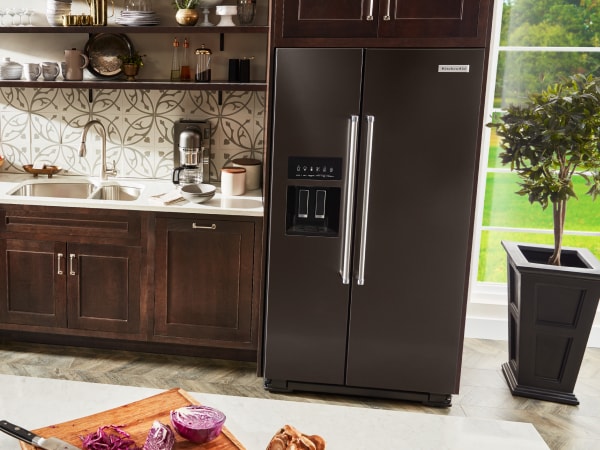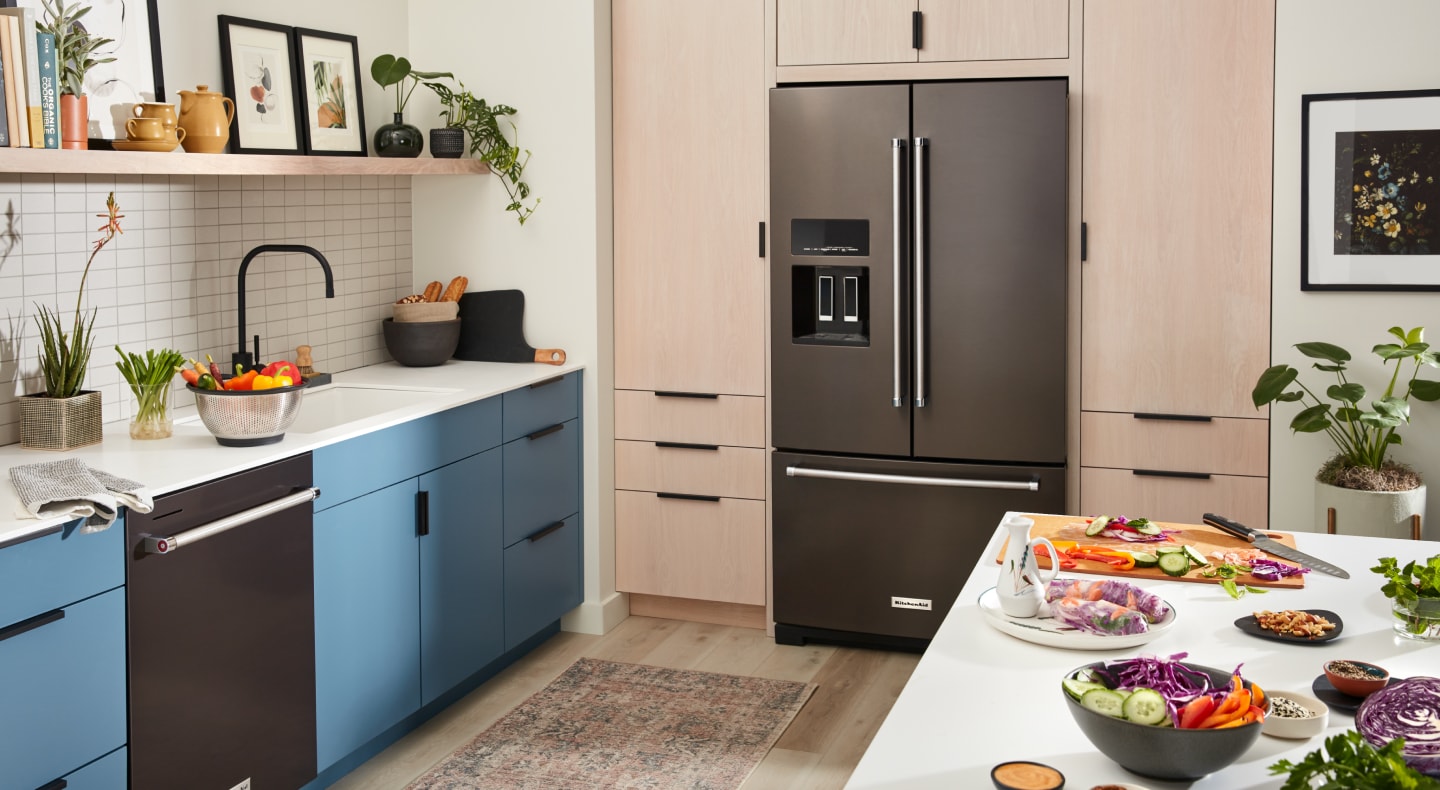
Why is my refrigerator not cooling and how to fix it?
Keeping ingredients at peak freshness can be the key to creating flavorful dishes and a refrigerator that won’t keep its contents cool may interrupt the way you make. Read through the guide below to learn 6 possible reasons for a refrigerator not cooling, as well as ideas for troubleshooting problems. Discover the ideal temperature for a refrigerator and learn how to reset the compressor.


What’s the first thing to check when a refrigerator stops cooling?
You may be able to save yourself some time and elbow grease by first checking the most simple causes of a refrigerator that stops cooling. Before you dive in too deep, double check that your refrigerator is plugged in and the switch to your kitchen appliances on the breaker box is on. Then, take a look at your refrigerator’s thermostat and make sure it’s set between 33ºF - 40ºF for optimal performance.


6 possible reasons my refrigerator is not cooling and ideas on how to fix it
Your refrigerator may not be cooling for reasons as simple as a flipped breaker or as complex as a faulty circuit board. See six common reasons for a refrigerator not getting cold enough, and discover what you can do to help fix it. Be sure to reference your refrigerator owner’s manual throughout the process for more information.

1. Grimy or broken gaskets
Gaskets are made of soft, flexible rubber and line the perimeter of your refrigerator door on the inside. They’re designed to help hold cold air, but spills, splatters, dust and tears can wear down the seal over time and cause cold air to leak.
Possible solution
Use a sponge and warm, soapy water to thoroughly wipe down the refrigerator gaskets from top to bottom. This should help remove any dirt and grime that’s preventing the refrigerator from sealing properly. If you notice cold air continuing to escape after cleaning the gaskets, you may need to consult a technician to find out if gasket replacement is necessary. Use this guide from KitchenAid brand to learn more tips for cleaning your refrigerator.

2. Food organization
Keeping your refrigerator well organized does more than make it easier to find what you’re looking for. Crowded refrigerators may house a few too many casserole dishes, ingredients or beverages that obstruct the air vents and prevent proper airflow throughout the compartment.
Possible solution
Reorganize your refrigerator and toss out any old food crowding the space to make sure air vents are as unobstructed as possible. Follow this guide from KitchenAid brand to learn tips for organizing your refrigerator to maximize space.

3. Poor refrigerator clearance
Refrigerators need space to release heat that’s generated when vapor refrigerant condenses into liquid and may not cool well without it. A refrigerator that’s too close to cabinetry, other appliances or the wall behind it may struggle to release heat properly and maintain temperature.
Possible solution
Give your refrigerator room to release heat by shifting its place with at least ½ inch of clearance on the sides and 1 inch in the back. Every model is different, so be sure to refer to your refrigerator’s installation instructions for specific guidance on the clearance space needed to perform at its best.

4. Dirty condenser coils
Condenser coils are the pipes located on the back or bottom of the refrigerator that work in tandem with the compressor to cool the refrigerant, helping release heat in the process. It’s easy for coils to collect dust, pet hair or cobwebs over time, which could make it harder for them to release heat and help the refrigerator maintain proper temperatures. Learn more about how refrigerators work.
Possible solution
Regularly cleaning the condenser coils can help prevent this. Your refrigerator’s product manual will likely let you know how often your model requires condenser coil cleaning, but generally you can plan on cleaning the coils every 2-3 months. After making sure the coils are cool, you may consider wiping them down more often if your refrigerator is in a uniquely dusty or greasy environment, or if you have pets.

5. Broken condenser fan
Most refrigerators come equipped with at least one condenser fan located on the back of the unit. The fan is designed to help keep the condenser coils and compressor cool, but it can break down or get stuck during operation.
Possible solution
Check to see if the condenser fan appears to be running smoothly. If it doesn’t seem to be operating properly, it might be time to consult a technician for a diagnosis and repair.

6. Faulty circuit board
The circuit board is the main hub of your refrigerator’s operation, controlling everything from temperature regulation and the ice maker to lighting and component operation. If the functions listed above do not seem to be running smoothly, a faulty circuit board may be the cause of a refrigerator not getting cold enough.
Possible solution
Diagnosing a faulty circuit board requires input from a professional. If you suspect your refrigerator’s circuit board has malfunctioned, schedule a service call to find out if you need a replacement.
If it’s time to upgrade your refrigerator, explore the line-up of KitchenAid® built-in, French-door, multi-door and side-by-side refrigerators. No matter the configuration, KitchenAid® refrigerators are crafted with high-end details and features that optimize storage and help keep food fresh.

Find the right refrigerator for your kitchen

Learn more about refrigerator sizes


How do I reset my refrigerator compressor?
Resetting the refrigerator is a simple process that can help the compressor get back on track. A quick reset can be effective for anyone looking to adjust fridge temperature or resolve other functionality issues. Reference your refrigerator owner’s manual for any specific instructions on resetting your refrigerator, then see the steps below to get started.
Step 1: turn off power
Shutting off the power to the refrigerator will give all of its systems—including the compressor—time to reset. Power down your refrigerator by unplugging it from the wall or shutting off the circuit breaker connected to the fridge. Leave the unit unplugged for five to ten minutes.
Step 2: restore power
Reconnect your refrigerator to power by plugging it back in or switching the circuit breaker back on. You’ll likely hear whirring or pulsating sounds as the compressor starts working to cool the refrigerator.
Step 3: adjust temperature settings
Readjust your refrigerator and freezer temperature controls to your desired temperature setting. Keep in mind that your refrigerator should be at or below 40°F, and it could take up to 24 hours for your refrigerator’s temperature to stabilize. If you find that your freezer isn’t freezing properly or your freezer is getting too cold, learn common causes and ways to troubleshoot.


What temperature should refrigerators be at?
Your refrigerator owner’s manual will recommend an optimal refrigerator temperature, but generally you should aim to keep your refrigerator between 33ºF - 40ºF. Your refrigerator is likely cold enough when your beverages are as cold as you’d like them, there’s no ice on your food and your fresh foods don’t spoil early. You’ll probably achieve an optimum chill around 37ºF.


How warm can a refrigerator get before food goes bad?
Keeping your refrigerator at or below 40°F can help prevent bacterial growth, particularly with foods like meat, produce, dairy and eggs. If you’re concerned that your refrigerator is too warm, you can keep an eye out for signs like food spoiling more quickly than usual or odors that can accompany spoilage.
What should I do if my refrigerator is too warm?
Troubleshooting a refrigerator that’s too warm can take some time, but there are some measures you can take to help keep cold air in the refrigerator in the meantime. While you work through the troubleshooting list above, try to avoid opening the refrigerator door frequently so less cool air escapes. That may mean doing things like unpacking and organizing refrigerated groceries first, then loading them all into the refrigerator at once. You might also keep foods like dairy and meats towards the back of the refrigerator where it tends to be cooler so they’re less prone to early spoilage.

MULTI-DOOR REFRIGERATOR
Plenty of room for fresh and frozen fruits
Keep your favorite fresh and frozen foods organized just the way you like with this multi-door French door refrigerator
Shop KitchenAid® Refrigerators
KitchenAid® refrigerators have the features you need to keep food fresh and organized. Select models include the ExtendFresh™ Temperature Management System that monitors the refrigerator and freezer temperatures separately to help prevent fresh foods from freezing and frozen foods from becoming freezer burnt. Plus, some models include the FreshChill™ Temperature-Controlled Full-Width Pantry that gives you control over the amount of cool air that enters the drawer for even more customized food storage.

KitchenAid® Hardware Accessory Kits
Curate the colors and textures that move you
From bold Black Ore to the inviting warmth of Bronze, mix and match handles and knobs to refresh your appliances and bring new energy to your kitchen